Malaysian Armed Forces
The Malaysian Armed Forces (Abbr.: MAF; Malay: Angkatan Tentera Malaysia; Jawi: اڠكتن تنترا مليسيا), are the armed forces of Malaysia, consists of three branches, the Malaysian Army, Royal Malaysian Navy and the Royal Malaysian Air Force. MAF active personnel is 113,000 and the reservist is 51,600.[1] The Supreme Commander of the Malaysian Armed Forces is the Yang di-Pertuan Agong who is the King of Malaysia.
| Malaysian Armed Forces | |
|---|---|
| Angkatan Tentera Malaysia (Malay) | |
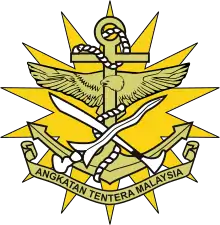 Crest of the Armed Forces | |
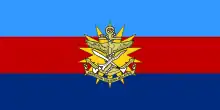 Flag of the Armed Forces | |
| Founded | 1 March 1933 |
| Service branches |
|
| Headquarters | Mindef Camp, Kuala Lumpur |
| Website | Official website |
| Leadership | |
| Supreme Commander | |
| Prime Minister | |
| Minister of Defence | |
| Chief of Defence Forces | |
| Personnel | |
| Military age | 18 |
| Available for military service | 15,000,000, age 18–49 (2017 est.) |
| Fit for military service | 12,425,000, age 18–49 (2017 est.) |
| Reaching military age annually | 520,000 (2017 est.) |
| Active personnel | 113,000[1] |
| Reserve personnel | 51,600[1] |
| Expenditures | |
| Budget | RM 17.4 billion (FY2022)[2] |
| Industry | |
| Domestic suppliers |
|
| Foreign suppliers | |
| Related articles | |
| History | Military history of Malaysia |
| Ranks | Military ranks of Malaysia |
Background
Malaysia's armed forces were created from the unification of military forces which arose during the first half of the 20th century when Malaya and Singapore were the subjects of British colonial rule before Malaya achieved independence in 1957. The primary objective of the armed forces in Malaysia is to defend the country's sovereignty and protect it from any and all types of threats.[4]
It is responsible for assisting civilian authorities to overcome all international threats, preserve public order, assist in natural disasters and participate in national development programs. It is also sustaining and upgrading its capabilities in the international sphere to uphold the national foreign policy of being involved under the guidance of the United Nations (UN).
Theater of operation
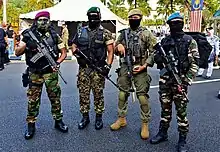
The main theaters of operations were within Malaysian borders, primarily to fight an insurgency led by the Communist Party of Malaya (CPM) in what was known as the Emergency. The only foreign incursion of Malaysian territory in modern times were in World War II by Japan (Malaya was then not a unified political entity and consisted of the British Crown Colony of the Straits Settlements, and the British protected Federated Malay States and Unfederated Malay States) and during the Indonesia-Malaysia confrontation by Indonesia under the leadership of President Sukarno. Operations on foreign soil have mainly been peacekeeping operations under the auspices of the United Nations.
- First Emergency (1948–1960)
- An insurrection and guerrilla war of the Malayan National Liberation Army organised by the CPM against the British and Malayan administration.
- Moro attacks on Malaysia (Part of the Piracy in the Sulu Sea) (1962–present)
- Congo Peacekeeping Mission (1960–1962)
- A contingent of 1,947 personnel were dispatched as part of the United Nations Operation in the Congo or ONUC. This contingent was known as the Malayan Special Force to the Congo and their experiences there were later recounted through the drawings of the cartoonist, Rejabhad.
- Sarawak Communist Insurgency (1963–1990)
- An insurrection and guerrilla war of the Sarawak Communist Organisation (from 1971, the North Kalimantan Communist Party or NKCP) against the British and Malaysian governments to establish an independent nation comprising the states of Sabah, Sarawak and Brunei. The insurgency ended when the NKCP signed a peace treaty with the Malaysian government in 1990.
- Indonesia-Malaysia confrontation (1963–1966)
- An intermittent armed conflict between Malaysia and Indonesia with skirmishes mainly occurring in Sarawak and Sabah in the island of Borneo. In 1964, armed raids were made on Peninsular Malaysia. Combat eased with the deposing of Indonesia's President Sukarno in 1965 by the Indonesian army and the conflict was declared over by both sides in 1966.
- Communist insurgency in Malaysia (1968–89)
- A low level resurgence of insurgent activity by the armed elements of the CPM from sanctuaries in the Malaysian-Thai border. The insurgency was only ended after the CPM signed a peace treaty with the Governments of Malaysia and Thailand on 2 December 1989.
- Iran/Iraq Border (1988–1991)
- Participated as part of the UN Iran-Iraq Military Observer Group (UNIIMOG) to supervise the Iran–Iraq War ceasefire.
- Namibia (1989–1990)
- Contributed a battalion to the UN Transition Assistance Group (UNTAG) to supervise Namibia's elections and transition to independence.
- Western Sahara (1991–present)
- A contingent of observers under the Mission for the Referendum in Western Sahara (MINURSO) to help implement a ceasefire between the Polisario Front & Morocco and help promote referendum on area's future.
- Angola (1991–1995)
- A contingent was sent under the United Nations Angola Verification Mission II (UNAVEM II) to enforce the ceasefire in Angolan civil war.
- Iraq/Kuwait Border (1992–2003)
- A contingent was sent under the United Nations Iraq-Kuwait Observation Mission (UNIKOM) to monitor the demilitarised zone along the Iraq-Kuwait border, deter border violations and report on any hostile action.
- Cambodia (1992–1993)
- An observer team was sent under the United Nations Transitional Authority in Cambodia (UNTAC) to aid in the administration of Cambodia and to organise and run elections.
- Bosnia and Herzegovina (1993–1998)
- A peacekeeping contingent known as MALBATT Command (Malaysia Battalion) was sent initially under the United Nations Protection Force (UNPROFOR) from 1993 to 1995 with deployments at Konjic, Jablanica and Pazarić in Hadžići. Following the Dayton Agreement, forces were redeployed as MALCON Command (Malaysia Contingent) under the NATO led Implementation Force (IFOR) in Operation Joint Endeavor with deployments at Livno, Glamoč and Kupres. MALCON further participated as part of the NATO led Stabilisation Force (SFOR) until 1998. Up to 8,000 troops were eventually deployed in this theatre of operations.
- Liberia (1993–1997)
- An observer team of 3 officers was sent under the United Nations Observer Mission in Liberia (UNOMIL) to support the efforts of the Economic Community of West African States (ECOWAS) and the Liberian National Transitional Government to implement peace agreements signed between the warring parties in Liberia.
- Somalia (1993–1994)
- A contingent known as MALBATT was sent under the United Nations Operation in Somalia II (UNOSOM II) to take appropriate action, including enforcement measures, to establish throughout Somalia a secure environment for humanitarian assistance. During its deployment, MALBATT was involved in the Battle of Mogadishu which saw 1 personnel killed in action and 7 others wounded in action during the relief operations to aid the surrounded troops of the United States' Task Force Ranger. On 18 January 1994, Lieutenant General Abu Samah Bin Abu Bakar was appointed the Commander of UNOSOM II forces. His appointment also saw the United Nations revise the mandate of UNOSOM II to stop using "coercive methods" in the discharge of their duties while retaining "some capability to defend its personnel if circumstances so warrant."[5]
- Mozambique (1993–1995)
- A team of observers were sent under the United Nations Operations in Mozambique (ONUMOZ).
- Lahad Datu standoff (2013)
- Deployed in South Lebanon on peace keeping role at present after the withdrawal of Israeli Military forces early 2007 (Invasion of South Lebanon by Israeli Military). Unit also consist of GGK, PASKAL, PASKAU and PARA elements.[6]
- Deployed a contingent called Malaysian Medical Team (MASMEDTIM) to Chaman, Pakistan to treat refugees from Afghanistan during the US invasion of Afghanistan in 2001.
- Deployed approximately a brigade-sized force on islands surrounding Sabah waters in Ops Pasir to prevent the recurrence of 2000 Sipadan kidnappings.
- Deployed a contingent to Acheh after the tsunami disaster in 2004.
- Deployed MASMEDTIM to Pakistan during the 2005 quake.
- Deployed in Southern Philippines as a part of monitoring force agreed upon by both the Philippine Government and Moro Islamic Liberation Front (MILF).
- Deployed in East Timor/East Leste together with Australian, Portuguese and New Zealand forces at the request of East Timor Government. The first team of 25 soldiers from 10 Para Brigade, Royal Intelligence Corp and Commando Regiment were deployed on a fact-finding mission before being reinforced by another 209 soldiers. (as at 27 May 2006)
Other limited participation under UNPKO are United Nations International Police Force (UNIPTF) since December 1995; United Nations Mission in Kosovo (UNMIK) since June 1999; United Nations Observer Mission in Sierra Leone (UNAMSIL) since October 1999; United Nations Transitional Administration in East Timor (UNTAET) since September 1999 and United Nations Organisation Mission in Democratic Republic of Congo (MONUC) since February 2000. 18 Malaysian Armed Forces personnel have been killed during UN peacekeeping operations.
Present development
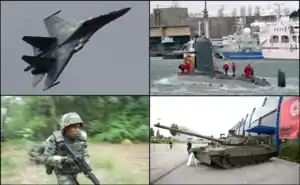
Malaysian defence requirements are assigned to the Malaysian Armed Forces (Angkatan Tentera Malaysia – ATM). The armed forces has three branches, the Malaysian Army (Tentera Darat Malaysia – TDM), Royal Malaysian Navy (Tentera Laut Diraja Malaysia – TLDM) and the Royal Malaysian Air Force (Tentera Udara Diraja Malaysia – TUDM). Malaysia does not have conscription, and the required minimum age for voluntary military service is 18.[7]
In the early 1990s, Malaysia undertook a major program to expand and modernise its armed forces. However, budgetary constraints imposed by the 1997 Asian financial crisis held many of the procurement. The recent economic recovery may lead to relaxation of budgetary constraints on the resumption of major weapons purchases. In October 2000, the Defence Minister also announced a review of national defence and security policy to bring it up to date. The review addressed new security threats that have emerged in the form of low intensity conflicts, such as the kidnapping of Malaysians and foreigners from resort islands located off the east coast of the state of Sabah and risk rising territory dispute with several neighbour countries. Currently, 1.4% of Malaysia's GDP is spent on the military, which employs 1.23% of Malaysia's manpower.[7] Dr Kogila Balakrishnan is the head of the Defence Industry.
Malaysian Army
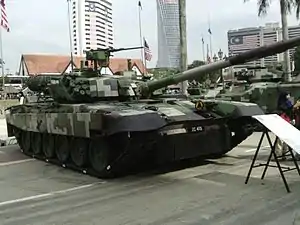
Since the recovery from the 1997 economic crisis, the army's modernisation programme has gained momentum. The acquisition of Main Battle Tank (MBT), Armoured Personnel Carrier (APC), Infantry Fighting Vehicle (IFV) and modern artillery make the army as one of the potent power in the region.
Royal Malaysian Navy
_and_KD_Jebat(FFG29)_with_USS_George_Washington_(CVN_73).jpeg.webp)
Following the completion of the New Generation Patrol Vessel (NGPV) program, Malaysia now moved to the next program called Second Generation Patrol Vessel (SGPV). Malaysia is also looking to purchase more submarine as well as a batch of Littoral Mission Ship (LMS) and Multi Role Support Ship (MRSS). In addition, an upgrade programme and Service Life Extension Programme (SLEP) for the old navy's ship will keep the fleet modern with the latest technology needed.
Royal Malaysian Air Force
.jpg.webp)
RMAF has traditionally looked to the West for its purchases, primarily to the United States and Europe. However, limitation imposed by the United States on "new technology" to the region made RMAF consider purchases from Russia and other non-traditional sources. Currently, RMAF operates a unique mix of American, European and Russian-made aircraft.
Forming of Marine Corps
Defence Minister Hishammuddin Tun Hussein said in a statement on 10 October 2013, Malaysia is planning on establishing a marine corps for amphibious operation.[8] The marine corps will be drawn from all three services and the bulk of it is from one of the three parachute battalions of the 10th Parachute Brigade which will be re-designated as a marine battalion. The 9th Royal Malay Regiment (Airborne) and 8th Royal Ranger Regiment (Airborne) have both conducted amphibious warfare training as a secondary mission such as CARAT exercise with the US Marine Corps (USMC) and others amphibious exercise also conducted with other foreign armed forces.[9]
Defence industry
After independence, Malaysia moved forward by establishing and developing their own defence industry. Malaysia has improved their defence industry through their defence companies by locally manufactured and produced weapons such as ammunitions, rifles, armoured cars, warships and light aircraft including unmanned aerial vehicle for the armed forces. DefTech, Mildef International Technologies and Weststar Defence Industries are the local company that emphasizes in the maintenance and manufacturing of military land vehicle and automotive sector while Sapura company focus more in military electronics and systems integration such as communication systems, tactical systems, command and control systems, training and simulation systems and surveillance systems.[10] In January 2021, Mildef International Technologies has launched its new Mildef Tarantula HMAV intended for local market and export.[11] In Defence Services Asia (DSA) 2022, Mildef International Technologies has launched its second armoured vehicle called Mildef Rentaka 4x4.[12] Another local company, Cendana Auto also introduces its new Cendana Auto Rover which is ready to deliver to the Malaysian Army.
As a country with vast maritime area, Malaysia has long had a great shipbuilding industry since the Malacca Sultanate empire where this land had been the main shipbuilding area in the region. Nowadays, Malaysia owns a lot of shipbuilding companies in a country with great expertise and facilities. Through local companies such as Boustead Heavy Industries Corporation, Destini Berhad, TH Heavy Engineering and Gading Marine, Malaysia able to locally built their own major surface combatants and combat boats with the latest and state of the art technology. In addition, local companies such as Labuan Shipyard and Engineering, Malaysia Marine and Heavy Engineering and others also able to executes minor and major maintenance and overhaul to the naval grade vessels locally without need to send it to the oversea. Some of this great achievement can be seen when Malaysia succeed completed its Scorpene-class submarine major overhaul and upgrade program locally by Boustead where this program done at RMN submarine base in Labuan, Sabah. Malaysia also already export their naval vessels to the foreign navy such as Shin Yang-made Al-Quwaisat-class LST to the United Arab Emirates navy and Northern Shipyard-made Manta MkII-class fast interdiction combat boat to the Nigerian navy where this combat boats marketed under the Singapore-based company, Suncraft Private Limited.[13][14]
In the aerospace sector, it is no doubt Malaysia is one of the aerospace hubs in the region. AIROD is some of the only outside company that received certificate from United States (US) based defence company, Lockheed Martin as the C-130 MRO centre outside the US. In 2015, United States Marine Corps awarded AIROD to do the MRO works onto its 13 units of C-130 that based in Japan.[15] Besides C-130, AIROD also owned an expertise in serving other type of commercial and military aircraft and had served to the customer across the region. Like AIROD, other local aerospace company namely ATSC also play an important role in aerospace industry in Malaysia. This company focus more in serving MRO for Russian-built aircraft such as Sukhoi Su-30, MiG-29 and Mil Mi-17. In 2017, ATSC was awarded a contract to do a major overhaul and upgrade for the RMAF Sukhoi Su-30 MKM fleet.[16] Since 1990s, Malaysia through SME Aerospace and CTRM has been manufacturing aircraft components such as wing parts, nacelles, composites structures and helicopter parts for the Airbus company. This aerostructure part includes for A320, A330, A350, A380, A400 and Airbus helicopter.[17] Other than that, SME Aerospace also manufactured pylon for BAE Systems Hawk AJT for the worldwide customer.[18] Although Malaysia don't built major aircraft locally or with partnership, but Malaysia already had an experience in building the light aircraft such as SME Aero Tiga and CTRM Eagle Aircraft Eagle 150. In addition, CTRM also had built their indigenous unmanned aerial vehicle called CTRM Aludra.[19]
In 1969, Malaysia set up their firearms manufacturing company, SME Ordnance. Started with the humble step by manufacturing ammunition locally, now SME Ordnance able to manufacturing high-tech firearms. In 1991, SME Ordnance acquired a licence to manufacture Austria-made Steyr AUG rifles locally. By 2001, SME Ordnance moving forward by acquiring a licence to manufacture US-made M4 Carbine rifles locally.[20] Both locally manufactured Styer and M4 rifles currently uses by Malaysian Armed Forces and other government agencies. Beside that, SME Ordnance also provides the wide range of NATO standard ammunitions starting from 5.56 mm to 155 mm calibre, mines, explosions and rockets. Another local firearms company Aegis Malinnov also developed indigenous pistols called Malinnov M1P intended to be uses by Malaysian government agencies.[21]
Malaysia also had their own defence technology research statutory board. Science Technology Research Institute for Defence (STRIDE) is the statutory board under the Ministry of Defence (Malaysia). Its responsible for performing research and development related to the defence technology for the Malaysian Ministry of Defence and Malaysian Armed Forces.[22]
International action
The Five Power Defence Arrangement (FPDA) between Malaysia, Singapore, Australia, New Zealand and the United Kingdom is a regional security initiative which has been in place for more than 45 years. It involves joint military exercises held between the five countries.[23]
Malaysia also actively takes part in international exercise such as CARAT,[24] RIMPAC[25] and COPE.[26] Joint exercises and war games also been held with Brunei,[27]Indonesia,[28]France[29] and the United States.[30] Besides that, Malaysia, Philippines, Thailand and Vietnam have agreed to host joint security force exercises to secure their maritime border and tackle issues such as illegal immigration, piracy and smuggling.[31][32][33]
Previously there are fears that extremist militants activities in the Muslim areas of the southern Philippines[34] and southern Thailand[35] could spill over into Malaysia. Due to this, Malaysia began to increase its border security.[34]
See also
- Malaysian Army
- Royal Malaysian Navy
- Royal Malaysian Air Force
- Malaysia Coast Guard
- Royal Malaysia Police
- Royal Johor Military Force
- Joint Forces Command
- Malaysian National Service
References
- International Institute for Strategic Studies (25 February 2021). The Military Balance 2021. London: Routledge. p. 281. ISBN 9781032012278.
- "Malaysia announces 5.3% defence budget increase - Jane's 360". www.janes.com. Archived from the original on 7 March 2018. Retrieved 22 March 2018.
- "Arms Transfers". Stockholm International Peace Research Institute. Retrieved 30 August 2015.
- Babatunde Fagoyinbo, Joseph (2013). The Armed Forces: Instrument of Peace, Strength, Development and Prosperity. Author House. ISBN 978-1477218440.
- UN Chronicle: "Mandate for UNOSOM II revised; 'coercive methods' not to be used – UN Operation in Somalia emphasizes nation building", June 1994
- "UNIFIL Troop-Contributing Countries". UNIFIL. 14 March 2016. Retrieved 2 October 2019.
- "Malaysian Military statistics". NationMaster. Retrieved 1 October 2010.
- "Malaysia to establish a marine corps, naval base close to James Shoal". IHS Jane's 360. Retrieved 18 October 2013.
- "US Marines and Malaysian Soldier Completed Malaysia-United States Amphibious Exercise".
- Balakrishnan, Kogila (2008). "Defence Industrialisation in Malaysia". Security Challenges. 4 (4): 135–155. JSTOR 26459817.
- "Unifil Contender Out on Show".
- "DSA 2022 Mildef Rentaka".
- "MRSS As Well, Plan B Shorts - Malaysian Defence".
- "Northern Shipyard from Malaysia finalizes construction of four Manta Mk II patrol boats for Nigerian Navy".
- "Airod secures contract to maintain US Navy aircraft". 9 November 2015.
- "First Overhauled Malaysian Su-30MKM Aircraft to Debut at LIMA 19". Defense Aerospace news, exhibitions, contracts and procurement. Retrieved 29 September 2020.
- "Airbus to keep growing with Malaysia". Archived from the original on 9 July 2021. Retrieved 4 July 2021.
- "BAE strengthens ties with SMEA, orders more Hawk parts | The Star". www.thestar.com.my.
- "Pesawat UAV Aludra MK helang perisik ciptaan tempatan" [Aircraft UAV Aludra MK 'eagle' local creation spy] (in Malay). UTUSAN MELAYU. 12 December 2007. Archived from the original on 4 March 2018. Retrieved 4 March 2018.
- "Products and Services". Archived from the original on 9 August 2011. Retrieved 22 March 2010.
- "BERNAMA - Malaysian-Made Pistol To Enter Market By Year-End". 22 April 2016. Archived from the original on 22 April 2016.
- "STRIDE Official Page".
- "Australia says major military exercise underway in Malaysia". My Sinchew. 26 April 2010. Archived from the original on 3 March 2016. Retrieved 1 October 2010.
- "U.S. Sailors and Marines Join the Malaysian Armed Forces for CARAT 2015".
- "A First: Malaysia to Deploy Warship for RIMPAC 2018".
- "Cope Taufan".
- Wood, Daniel (20 April 2014). "Brunei, M'sia train in 11th military exercise". The Brunei Times. Archived from the original on 8 December 2014. Retrieved 5 November 2014.
- "Indonesia-Malaysia military exercises must continue – defence minister". ANTARA News. 13 September 2010. Retrieved 1 October 2010.
- "French Navy FREMM Provence in ASW Exercise with Royal Malaysian Navy in South China Sea".
- "Malaysia, US armed forces in joint exercise". The Star. 25 August 2014. Retrieved 26 August 2014.
- "Malaysia, Philippines committed to enhancing border security". My Sinchew. 9 August 2010. Archived from the original on 3 March 2016. Retrieved 18 September 2010.
- "Piracy in Southeast Asia: Organised Criminal Syndicates or Small Scale Opportunists?" (PDF). Gray Page. April 2013. Archived from the original (PDF) on 24 July 2015. Retrieved 24 July 2015.
- Carvalho, Martin (15 May 2012). "Malaysia, Thailand military exercise to include other agencies, Asean members". The Star. Retrieved 5 November 2014.
- Pike, John. "Malaysia Intensifies Border Security Following US Warnings". GlobalSecurity.org. Retrieved 18 September 2010.
- Kent, Jonathan (28 April 2004). "Malaysia ups Thai border security". BBC News. Retrieved 18 September 2010.
Further reading
- Robert Karniol, 'Country Briefing: Malaysia,' Jane's Defence Weekly, 25 November 1995, p. 25–40
External links
- Malaysian Armed Forces Headquarters Website Archived 5 May 2014 at the Wayback Machine
- Perspective from a military personnel in The Liaison
- (malaysiandefence.com)
.svg.png.webp)